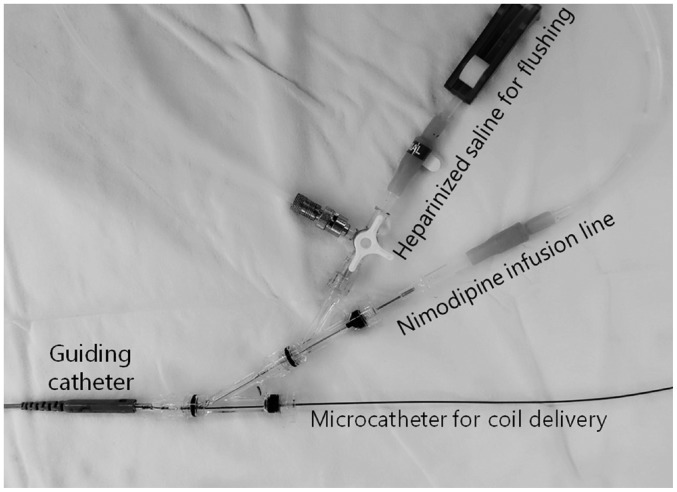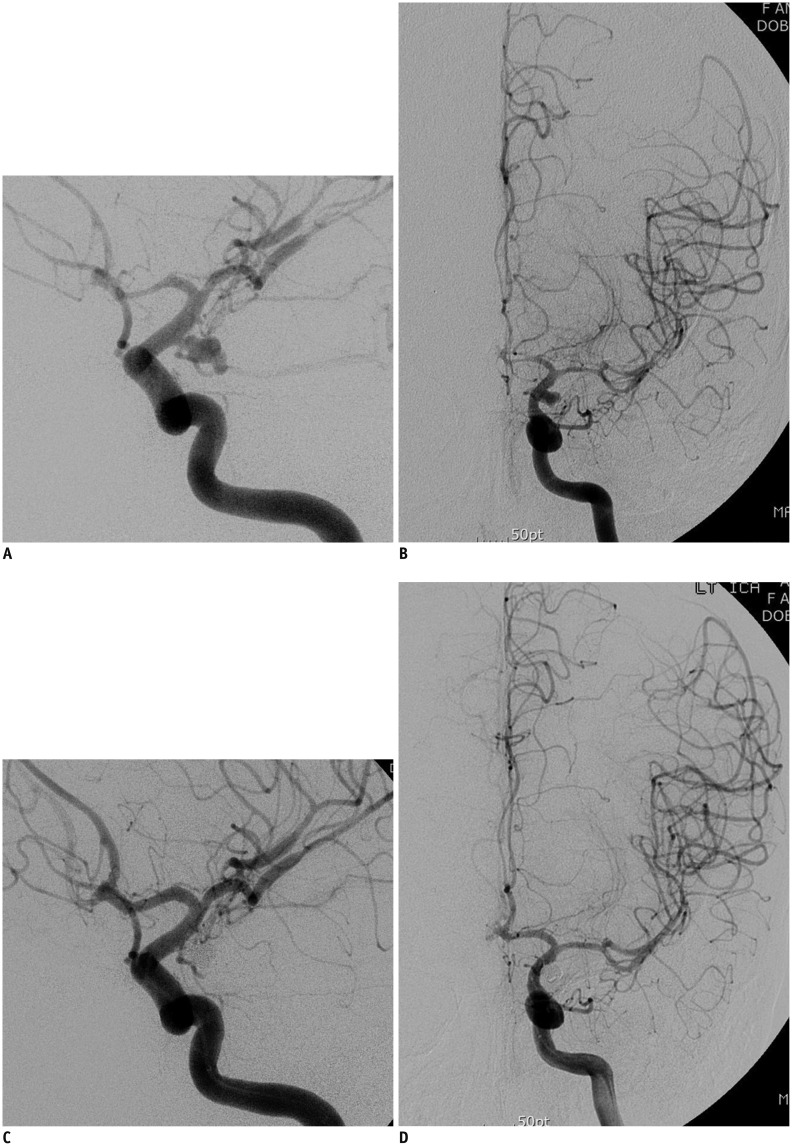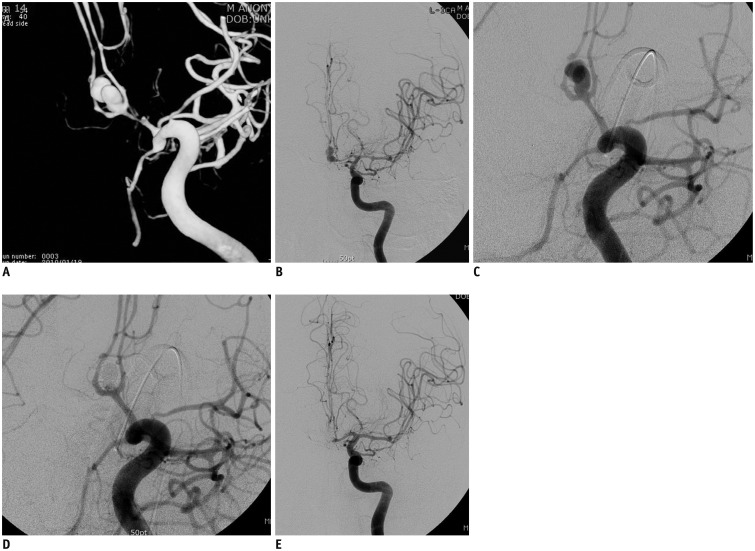Korean J Radiol.
2015 Feb;16(1):180-187. 10.3348/kjr.2015.16.1.180.
Simultaneous Endovascular Treatment of Ruptured Cerebral Aneurysms and Vasospasm
- Affiliations
-
- 1Department of Radiology, Seoul National University Hospital, Seoul National University College of Medicine, Seoul 110-744, Korea. hanmh@snuh.org
- 2Department of Neurosurgery, Seoul National University Hospital, Seoul National University College of Medicine, Seoul 110-744, Korea.
- 3Department of Neurosurgery, Hallym University Sacred Heart Hospital, Hallym University College of Medicine, Anyang 431-796, Korea.
- 4Department of Radiology, Asan Medical Center, University of Ulsan College of Medicine, Seoul 138-736, Korea.
- 5Department of Neurology, Stroke Center, Myongji Hospital, Goyang 412-270, Korea.
- 6Department of Neurosurgery, Sun Hospital, Daejeon 301-725, Korea.
- KMID: 2069998
- DOI: http://doi.org/10.3348/kjr.2015.16.1.180
Abstract
OBJECTIVE
The management of patients with ruptured cerebral aneurysms and severe vasospasm is subject to considerable controversy. We intended to describe herein an endovascular technique for the simultaneous treatment of aneurysms and vasospasm.
MATERIALS AND METHODS
A series of 11 patients undergoing simultaneous endovascular treatment of ruptured aneurysms and vasospasm were reviewed. After placement of a guiding catheter within the proximal internal carotid artery for coil embolization, an infusion line of nimodipine was wired to one hub, and of a microcatheter was advanced through another hub (to select and deliver detachable coils). Nimodipine was then infused continuously during the coil embolization.
RESULTS
This technique was applied to 11 ruptured aneurysms accompanied by vasospasm (anterior communicating artery, 6 patients; internal carotid artery, 2 patients; posterior communicating and middle cerebral arteries, 1 patient each). Aneurysmal occlusion by coils and nimodipine-induced angioplasty were simultaneously achieved, resulting in excellent outcomes for all patients, and there were no procedure-related complications. Eight patients required repeated nimodipine infusions.
CONCLUSION
Our small series of patients suggests that the simultaneous endovascular management of ruptured cerebral aneurysms and vasospasm is a viable approach in patients presenting with subarachnoid hemorrhage and severe vasospasm.
Keyword
MeSH Terms
-
Adult
Aged
Aneurysm, Ruptured/*therapy
Carotid Artery, Internal/radiography
Embolization, Therapeutic
*Endovascular Procedures
Female
Humans
Intracranial Aneurysm/*therapy
Magnetic Resonance Angiography
Male
Middle Aged
Nimodipine/therapeutic use
Retrospective Studies
Vasodilator Agents/therapeutic use
Vasospasm, Intracranial/*therapy
Nimodipine
Vasodilator Agents
Figure
Reference
-
1. Murayama Y, Song JK, Uda K, Gobin YP, Duckwiler GR, Tateshima S, et al. Combined endovascular treatment for both intracranial aneurysm and symptomatic vasospasm. AJNR Am J Neuroradiol. 2003; 24:133–139. PMID: 12533342.2. Aburto-Murrieta Y, Marquez-Romero JM, Bonifacio-Delgadillo D, López I, Hernández-Curiel B. Endovascular treatment: balloon angioplasty versus nimodipine intra-arterial for medically refractory cerebral vasospasm following aneurysmal subarachnoid hemorrhage. Vasc Endovascular Surg. 2012; 46:460–465. PMID: 22914892.3. Musahl C, Henkes H, Vajda Z, Coburger J, Hopf N. Continuous local intra-arterial nimodipine administration in severe symptomatic vasospasm after subarachnoid hemorrhage. Neurosurgery. 2011; 68:1541–1547. discussion 1547. PMID: 21311378.
Article4. Pierot L, Aggour M, Moret J. Vasospasm after aneurysmal subarachnoid hemorrhage: recent advances in endovascular management. Curr Opin Crit Care. 2010; 16:110–116. PMID: 20098322.
Article5. Brisman JL, Roonprapunt C, Song JK, Niimi Y, Setton A, Berenstein A, et al. Intentional partial coil occlusion followed by delayed clip application to wide-necked middle cerebral artery aneurysms in patients presenting with severe vasospasm. Report of two cases. J Neurosurg. 2004; 101:154–158. PMID: 15255267.6. Le Roux PD, Newell DW, Eskridge J, Mayberg MR, Winn HR. Severe symptomatic vasospasm: the role of immediate postoperative angioplasty. J Neurosurg. 1994; 80:224–229. PMID: 8283260.
Article7. Raymond J, Guilbert F, Weill A, Georganos SA, Juravsky L, Lambert A, et al. Long-term angiographic recurrences after selective endovascular treatment of aneurysms with detachable coils. Stroke. 2003; 34:1398–1403. PMID: 12775880.
Article8. Cho WS, Kang HS, Kim JE, Kwon OK, Oh CW, Son YJ, et al. Intra-arterial nimodipine infusion for cerebral vasospasm in patients with aneurysmal subarachnoid hemorrhage. Interv Neuroradiol. 2011; 17:169–178. PMID: 21696654.
Article9. Velat GJ, Kimball MM, Mocco JD, Hoh BL. Vasospasm after aneurysmal subarachnoid hemorrhage: review of randomized controlled trials and meta-analyses in the literature. World Neurosurg. 2011; 76:446–454. PMID: 22152574.
Article10. Fisher CM, Roberson GH, Ojemann RG. Cerebral vasospasm with ruptured saccular aneurysm--the clinical manifestations. Neurosurgery. 1977; 1:245–248. PMID: 615969.
Article11. Heros RC, Zervas NT, Varsos V. Cerebral vasospasm after subarachnoid hemorrhage: an update. Ann Neurol. 1983; 14:599–608. PMID: 6651248.
Article12. Cooke D, Seiler D, Hallam D, Kim L, Jarvik JG, Sekhar L, et al. Does treatment modality affect vasospasm distribution in aneurysmal subarachnoid hemorrhage: differential use of intra-arterial interventions for cerebral vasospasm in surgical clipping and endovascular coiling populations. J Neurointerv Surg. 2010; 2:139–144. PMID: 21990594.
Article13. Conti A, Angileri FF, Longo M, Pitrone A, Granata F, La Rosa G. Intra-arterial nimodipine to treat symptomatic cerebral vasospasm following traumatic subarachnoid haemorrhage. Technical case report. Acta Neurochir (Wien). 2008; 150:1197–1202. discussion 1202. PMID: 18958388.
Article14. Kim SS, Park DH, Lim DJ, Kang SH, Cho TH, Chung YG. Angiographic features and clinical outcomes of intra-arterial nimodipine injection in patients with subarachnoid hemorrhage-induced vasospasm. J Korean Neurosurg Soc. 2012; 52:172–178. PMID: 23115657.
Article15. Zubkov YN, Nikiforov BM, Shustin VA. Balloon catheter technique for dilatation of constricted cerebral arteries after aneurysmal SAH. Acta Neurochir (Wien). 1984; 70:65–79. PMID: 6234754.
Article16. Newell DW, Eskridge JM, Mayberg MR, Grady MS, Winn HR. Angioplasty for the treatment of symptomatic vasospasm following subarachnoid hemorrhage. J Neurosurg. 1989; 71(5 Pt 1):654–660. PMID: 2530321.
Article17. Zwienenberg-Lee M, Hartman J, Rudisill N, Muizelaar JP. Endovascular management of cerebral vasospasm. Neurosurgery. 2006; 59(5 Suppl 3):S139–S147. discussion S3-S13. PMID: 17053596.
Article18. Linskey ME, Horton JA, Rao GR, Yonas H. Fatal rupture of the intracranial carotid artery during transluminal angioplasty for vasospasm induced by subarachnoid hemorrhage. Case report. J Neurosurg. 1991; 74:985–990. PMID: 1827838.
- Full Text Links
- Actions
-
Cited
- CITED
-
- Close
- Share
- Similar articles
-
- Results of Surgical and Endovascular Treatment of Middle Cerebral Artery Bifurcation Aneurysms: Clinical Research
- Frequency and Characteristics of Paraclinoid Aneurysm in Ruptured Cerebral Aneurysms
- Use of Distal Intracranial Catheters for Better Working View of Cerebral Aneurysms Hidden by Parent Artery or Its Branches: A Technical Note
- Endovascular Treatment of Ruptured Dissecting Aneurysms on the P2-3 Segment of the Posterior Cerebral Artery: A Report of Two Cases
- Risk Factors for Intraprocedural Rerupture during Embolization of Ruptured Intracranial Aneurysms




